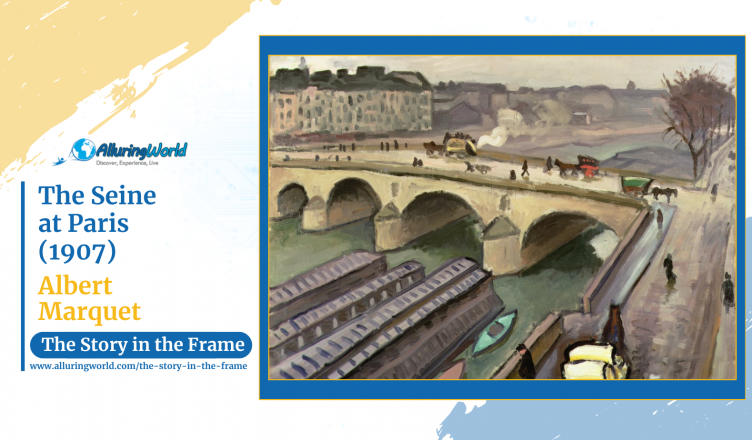Dated around 1907, The Seine at Paris is an evocative painting by Fauvist painter Albert Marquet. Painted in oil-on-canvas, the painting depicts the peaceful majesty of the Seine River winding through the middle of Paris, draped in silken, transparent light. Marquet’s ability to evoke the atmosphere of a location through simple but evocative brushwork makes this painting one of his most powerful expressions of visual imagination. While his Fauvist contemporaries painted with hot, unnatural colors, Marquet worked within a more restrained palette, highlighting light, atmosphere, and the subtle interaction of water, sky, and structure.
About the Painter:
Albert Marquet (1875–1947) was a French artist of atmospheric views of landscapes and cities, particularly of Paris and other seaport cities. In his early work, he was under Fauvist influence but then developed a more controlled idiom that indulged in naturalistic color and a sensitive treatment of light. Although he maintained friendships with artists like Henri Matisse, Marquet was more withdrawn and contemplative in his work, often painting from above in an attempt to show the grandeur of an environment. His paintings hover between Fauvism and Impressionism, harmonizing structure with motion.
Inspiration and Reasons Behind the Painting:
Marquet was fond of city landscapes, particularly the atmosphere of changing water and sky. His interest lies in capturing fleeting atmospheric states rather than dramatic or overblown color. His painting is part of a broader series in which he observed different hours of the day, weather, and seasons along the Seine. Paris, with its bridges, embankments, and ever-present river traffic, was a source of constant inspiration. His works always have the power to evoke a still poetry, and one can get lost in the peaceful rhythm of city life.
What is Depicted in the Painting:
The work is a broad panorama of the Seine River in Paris, likely from an elevated point of view that will yield a general overview. The river, which is set at the center of the composition, flows peacefully with hues that resemble the light blue of the sky. Rock walls border the water, inviting the viewer to notice a distant bridge and the silhouette of buildings lining the riverbanks. There are a couple of boats in the distance, their dark shape providing contrast to the muted tones of the water. The scene is uncluttered by crowded masses and has a peaceful ambiance of calm and contemplation, characteristic of Marquet’s work.
Colors and Techniques:
In contrast to the vivid, explosive hues of initial Fauvism, Marquet’s color in The Seine at Paris is subdued but consonant. Soothing tones of blue, gray, and pale ochre predominate in the painting, capturing the cool, misty atmosphere. His brushstrokes are fluid but restrained, with simplified shapes that suggest but do not define details. The water reflections are painted with delicate gradations of tone, imparting depth and movement. Marquet’s economy of means—few strong contours, great expanses of color, and smooth transitions—has a refined, almost meditative effect.
Conclusion:
The Seine at Paris is the perfect distillation of Albert Marquet’s own personal style of landscape painting, combining Fauvist vigor with a cooler, more atmospheric approach. His ability to capture the serenity and poetry of urban waterways sets him apart from his flashier contemporaries. The painting is a beautiful testament to the artist’s lifelong fascination with the interplay of light, water, and architecture, offering viewers a glimpse of the soft loveliness of Paris as seen through Marquet’s eyes.

